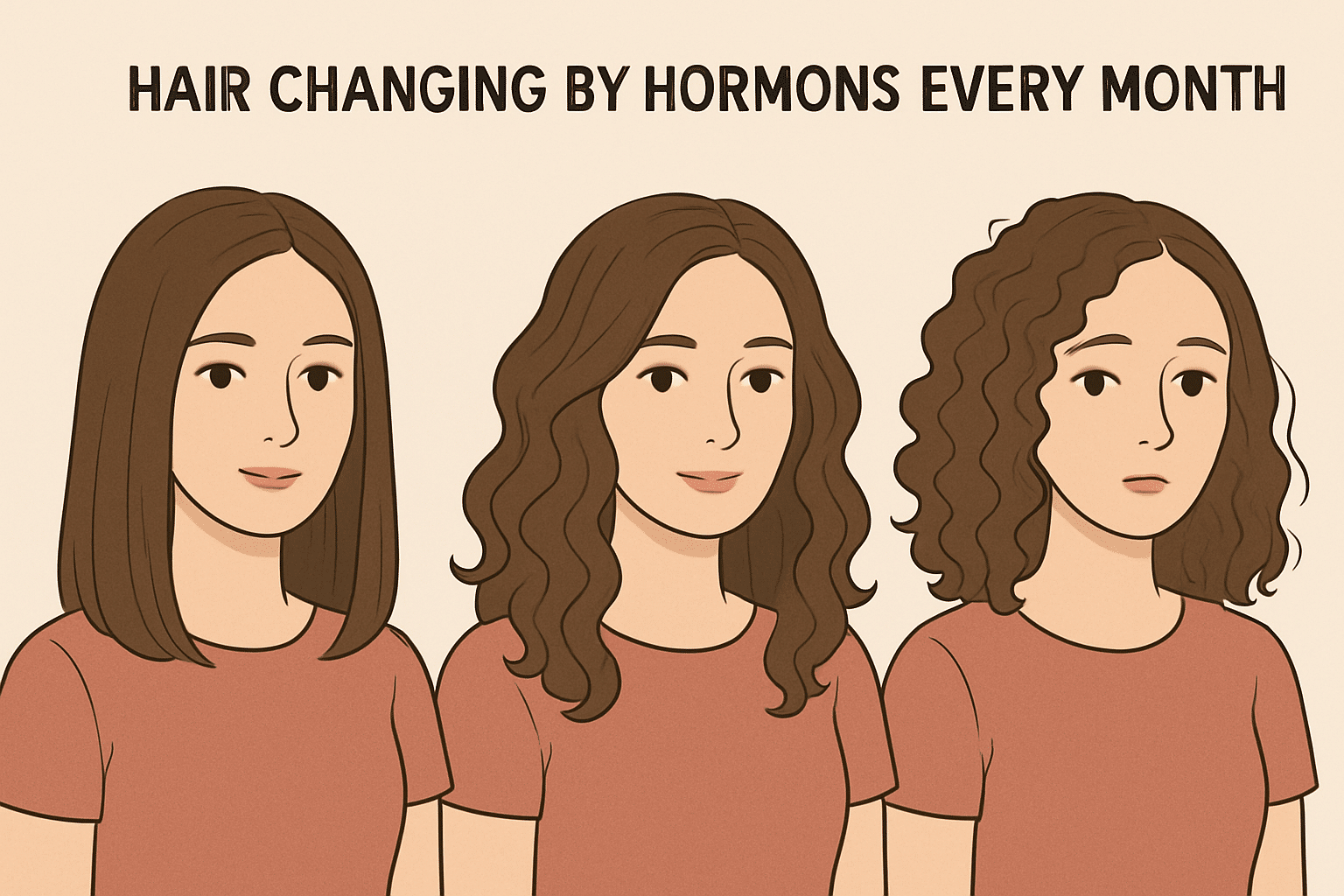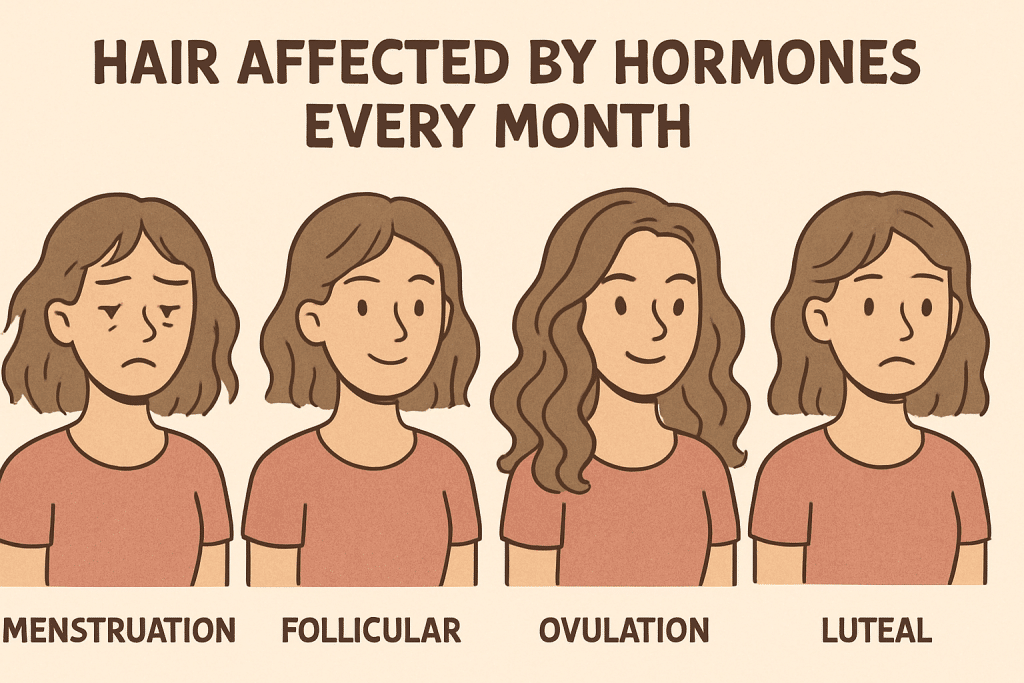
The Mysterious Monthly Changes in Your Hair
Have you ever wondered why your hair feels silky smooth one week, then unmanageably frizzy the next? The culprit behind these frustrating changes might not be your shampoo or the weather—it’s likely your hair texture hormones. These powerful chemical messengers fluctuate throughout your monthly cycle, subtly but significantly altering the way your hair looks, feels, and behaves.
For many women, especially those who wear hijab, these hair texture hormones create an additional layer of complexity in hair care. Just when you’ve figured out the perfect routine, your hair seems to change its mind about what it needs. This isn’t your imagination—it’s your endocrine system at work.
In this comprehensive guide, we’ll reveal the science behind how hair texture hormones affect your hair throughout the month, why these changes occur, and most importantly, how to adapt your hair care routine to work with—rather than against—these natural fluctuations.
The Science Behind Hair Texture Hormones
To understand the relationship between hair texture hormones and your ever-changing locks, we need to examine the key players in this biological drama.
The Main Hormonal Influencers

Several hormones impact your hair, but the most significant hair texture hormones include:
- Estrogen: Often called the “beauty hormone,” estrogen contributes to hair smoothness, shine, and growth. When estrogen levels are high, most women experience their best hair days.
- Progesterone: This hormone can increase sebum production, making hair oilier. It also affects how your hair cuticle lies, potentially causing more frizz and poorer moisture retention.
- Testosterone: Though present in smaller amounts in women, this hormone influences oil production and can affect hair thickness and growth patterns.
- Cortisol: This stress hormone doesn’t follow the monthly cycle but can spike during stressful periods, affecting how other hair texture hormones function.
According to research published in the International Journal of Dermatology, these hair texture hormones don’t just affect hair growth—they actually alter the protein structure of the hair shaft and influence how the cuticle (the outer layer of your hair) behaves.
How Hormonal Fluctuations Affect Hair Properties
The effects of hair texture hormones on your hair are surprisingly comprehensive:
- Porosity: Hormonal changes can temporarily alter how well your hair absorbs and retains moisture
- Elasticity: The stretchiness and bounce of your hair shifts with hormonal fluctuations
- Diameter: Some women experience actual thickening and thinning of individual hair strands through the month
- Cuticle alignment: The microscopic “shingles” on your hair shaft can lie flatter or stand up more based on hormonal signals
- Scalp oil production: Sebaceous glands respond directly to hormonal instructions
A study in the Journal of Cosmetic Science found that these changes are subtle but measurable, with hair diameter fluctuations of up to 10% throughout the monthly cycle due to hair texture hormones.
The 4-Phase Cycle: How Hair Texture Hormones Transform Your Hair Monthly
Your hair experiences predictable changes throughout your menstrual cycle, creating a pattern you can learn to anticipate and address. Here’s how hair texture hormones affect your hair during each phase:
Phase 1: Menstruation (Days 1-5)
During menstruation, both estrogen and progesterone levels are at their lowest, creating a unique environment for your hair:
- Typical hair characteristics: Tends to be dryer, more brittle, and prone to breakage
- Primary hair texture hormones at work: Low estrogen, low progesterone
- Common complaints: Lackluster appearance, static, difficulty styling
- Hair needs during this phase: Extra moisture, gentle handling, protective styling
This is often when women notice the most significant texture changes as hair texture hormones are at their monthly low point.
Phase 2: Follicular Phase (Days 6-14)
As estrogen rises in preparation for ovulation, your hair typically improves:
- Typical hair characteristics: Increasing shine, manageability, and strength
- Primary hair texture hormones at work: Rising estrogen, low progesterone
- Common benefits: Better moisture retention, less frizz, increased shine
- Hair needs during this phase: Normal maintenance, good time for treatments
Many women find their hair most responsive to styling during this phase when hair texture hormones create optimal conditions.
Phase 3: Ovulation (Day 14-16)
At ovulation, estrogen peaks briefly before beginning to decline:
- Typical hair characteristics: Usually your “best hair days” with maximum shine and manageability
- Primary hair texture hormones at work: Peak estrogen, beginning progesterone rise
- Common benefits: Maximum smoothness, shine, and volume
- Hair needs during this phase: Perfect time for photos, special styling, or haircuts
This phase represents the optimal balance of hair texture hormones for most women.
Phase 4: Luteal Phase (Days 17-28)
After ovulation, progesterone dominates while estrogen decreases:
- Typical hair characteristics: Increasing oiliness at the scalp but possible dryness at ends, more frizz
- Primary hair texture hormones at work: High progesterone, decreasing estrogen
- Common complaints: Increased oiliness, frizz, difficulty holding style
- Hair needs during this phase: Oil-balancing products, anti-frizz treatments, more frequent washing
During this phase, hair texture hormones often create conflicting conditions—oily roots but dry ends—making hair care particularly challenging.
How Hair Texture Hormones Affect Different Hair Types
The impact of hair texture hormones varies significantly depending on your base hair type:
Straight Hair
Women with straight hair often notice:
- More visible oiliness during the luteal phase
- Increased static electricity during menstruation
- Volume fluctuations throughout the cycle
- Changing responsiveness to styling products
For straight-haired women, hair texture hormones most noticeably affect volume and oil distribution.
Wavy Hair
Wavy hair typically experiences:
- Wave pattern intensification during the luteal phase
- Increased frizz during menstruation
- Better definition during the follicular and ovulation phases
- More unpredictable styling results as hormones fluctuate
The wave pattern itself may change due to hair texture hormones altering the hair shaft’s internal structure.
Curly Hair
Curly hair shows these hormonal effects:
- More pronounced frizz during progesterone-dominant phases
- Possible loosening of curl pattern during estrogen peaks
- Increased dryness during menstruation
- Varying product absorption throughout the cycle
Curly hair tends to be most reactive to hair texture hormones, with noticeable pattern changes throughout the month.
Coily/Kinky Hair
Women with coily hair often experience:
- Increased moisture needs during menstruation
- Better product absorption during the follicular phase
- More shrinkage during the luteal phase
- Varying degrees of elasticity throughout the cycle
The highly textured nature of coily hair makes it particularly responsive to changes in hair texture hormones.
Adapting Your Hair Care to Hormonal Fluctuations
Instead of fighting against these natural changes, adapting your routine to work with your hair texture hormones can transform your relationship with your hair.
Cycle-Syncing Your Hair Care
Create a hormonal hair care calendar by:
- Tracking your cycle: Note which days your hair feels best/worst
- Mapping products to phases: Use richer products during drier phases, lighter ones during oilier times
- Planning treatments strategically: Schedule deep conditioning during menstruation, clarifying treatments during the luteal phase
- Adjusting styling techniques: Opt for heat-free styles during more vulnerable phases
This strategic approach works with your hair texture hormones rather than against them.
Product Recommendations for Each Phase
Optimize your hair care by selecting products that address the specific needs created by hair texture hormones in each phase:
Menstruation (Days 1-5):
- Hydrating masks with ingredients like shea butter, argan oil, or hyaluronic acid
- Leave-in conditioners to provide ongoing moisture
- Protective styling products to minimize manipulation
Follicular Phase (Days 6-14):
- Balanced shampoos and conditioners that maintain hair health
- Protein treatments to capitalize on improved protein synthesis
- Styling products with medium hold
Ovulation (Days 14-16):
- Lightweight products that won’t weigh down naturally beautiful hair
- Heat protectants if using styling tools
- Shine-enhancing serums to enhance natural luster
Luteal Phase (Days 17-28):
- Clarifying shampoos to manage excess oil
- Anti-frizz serums containing dimethicone or argan oil
- Dry shampoo for extending time between washes
Lifestyle Factors That Affect Hair Texture Hormones
Beyond products and styling, consider these factors that influence how hair texture hormones affect your hair:
- Stress management: High cortisol can disrupt normal hormonal patterns
- Sleep quality: Poor sleep affects hormone production and balance
- Nutrition: Certain nutrients support healthy hormonal function
- Exercise: Regular activity helps regulate hormonal fluctuations
- Hydration: Water intake affects how hormones are metabolized and cleared
These lifestyle factors can either amplify or moderate the effects of hair texture hormones on your hair.
Special Considerations for Hijabis
For women who wear hijab, understanding hair texture hormones is particularly important, as hair is covered for much of the day, creating unique challenges.
How Hijab Affects Hormonal Hair Changes
The microenvironment created by hijab interacts with hormonal fluctuations:
- During oilier phases, the warm, covered environment can exacerbate oil production
- During drier phases, fabric friction can worsen brittleness
- The limited air circulation can intensify both positive and negative effects of hair texture hormones
Specialized Solutions for Covered Hair
Hijabi women can implement these strategies to work with hair texture hormones:
- Fabric selection by phase: Choose more breathable hijab materials during oilier hormonal phases
- Undercap rotation: Use moisture-wicking undercaps during high-progesterone phases
- Evening treatments: Apply phase-appropriate treatments after removing hijab in the evening
- Scalp care focus: Pay special attention to scalp health as hormones fluctuate
- Strategic washing schedule: Adjust washing frequency based on your hormonal phase
These adaptations help manage the unique interaction between hijab and hair texture hormones for optimal hair health.
Frequently Asked Questions About Hair Texture Hormones
Can birth control pills affect how hormones change my hair texture?
Yes, hormonal contraceptives significantly influence hair texture hormones. Birth control pills typically stabilize hormone levels, which can reduce the fluctuations in hair texture throughout the month. Some women notice their hair becomes consistently more manageable on hormonal contraceptives, while others experience increased oiliness or dryness. The specific effects depend on the type and dosage of hormones in your particular contraceptive.
Do hair texture hormones affect hair loss as well as texture?
Absolutely. Hair texture hormones don’t just change how your hair feels—they also influence the growth cycle. Many women notice slightly increased shedding during menstruation when estrogen levels drop. This temporary shedding is normal and typically resolves as estrogen rises again. However, persistent excessive shedding may indicate a hormonal imbalance rather than normal cyclical changes.
Do hair texture hormones affect women in perimenopause differently?
During perimenopause, hair texture hormones become less predictable, which often results in more noticeable and erratic hair texture changes. The declining estrogen levels characteristic of perimenopause can lead to permanent texture changes, including increased dryness, reduced diameter of individual strands, and in some cases, wave pattern changes. Adapting hair care routines to these new hormonal realities becomes especially important during this life stage.
Can men experience hair texture changes due to hormones too?
While men don’t experience the monthly fluctuations in hair texture hormones that women do, they aren’t immune to hormonal effects on hair. Men’s hair texture can change in response to stress hormones like cortisol, thyroid fluctuations, and age-related hormonal shifts. The effects are typically more gradual than the monthly changes women experience but can be equally significant over time.
Are there supplements that can help balance hair texture hormones?
Some supplements may help moderate the effects of hair texture hormones on your hair. These include omega-3 fatty acids, vitamin D, B-complex vitamins (especially biotin), zinc, and adaptogenic herbs like ashwagandha. However, before starting any supplement regimen aimed at hormonal balance, it’s essential to consult with a healthcare provider, as even natural supplements can have significant effects on your endocrine system.
Embracing Your Hair’s Natural Rhythm
Understanding hair texture hormones gives you unprecedented insight into why your hair behaves the way it does throughout the month. Rather than being frustrated by these changes, you can anticipate them, prepare for them, and even use them to your advantage.
By creating a hair care routine that works with—rather than against—your hormonal fluctuations, you’ll experience fewer “bad hair days” and develop a deeper appreciation for your body’s natural rhythms. The key is not fighting these changes but embracing them as part of your unique hair journey.
Remember that hormonal fluctuations are normal and healthy. Your shifting hair texture throughout the month is a sign that your body is functioning as designed—a reminder of the complex and beautiful biology that makes you uniquely you.
At Mohajba, we understand the complex relationship between hormones and hair health. Our approach combines scientific knowledge with practical solutions for women navigating the monthly changes in their hair.
Follow us on Instagram, Facebook, and TikTok for more insights about hair texture hormones and customized care tips for every phase of your cycle.
Visit our website to explore our curated collection of phase-specific hair care products designed to work harmoniously with your body’s natural rhythms.
Your hair deserves care that’s as dynamic and responsive as you are—because true beauty comes from working with nature, not against it.


Leave a Reply